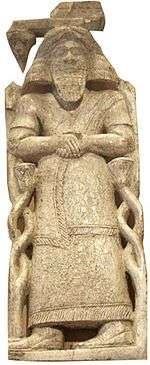Hazael
| Hazael | |
|---|---|
| (El/God has seen) | |
 Ivory inlay possibly depicting Hazael of Damascus | |
| King of Aram Damascus (King of Syria) | |
| Reign | 842 BC–796 BC |
| Predecessor | Hadadezer |
| Successor | Ben-Hadad III |
| Occupation | Court official |
Hazael (/ˈheɪziəl/; Hebrew: חֲזָהאֵל, Modern Ḥaza'ēl, Tiberian H̱azā'ēl;[1]; Aramaic: חזאל, from the triliteral Semitic root h-z-y, "to see"; his full name meaning, "El/God has seen"; Akkadian: 𒄩𒍝𒀪𒀭, translit. Ḫa-za-’-ilu) was a court official and later an Aramean king who is mentioned in the Bible.[2][3] Under his reign, Aram-Damascus became an empire that ruled over large parts of Syria and the Land of Israel.[4] While he was likely born in the greater Damascus region of today, his exact place of birth is still controversial, with both Bashan and the Beqaa Valley being favoured by different historians.[5][6][7]
In the Bible
| Arameans |
|---|
| Syro-Hittite states |
| Aramean kings |
| Aramean cities |
Hazael is first referred to by name in 1 Kings 19:15. God tells the prophet Elijah to anoint Hazael king over Aram Damascus. Years after this, the Syrian king Ben-Hadad II, probably identical to Hadadezer mentioned in the Tell Dan Stele, was ill and sent his court official Hazael with gifts to Elijah's successor Elisha. Elisha asked Hazael to tell Hadadezer that he would recover, and he revealed to Hazael that the king would recover but would die of other means. The day after he returned to Hadadezer in Damascus, Hazael suffocated him and seized power himself.
During his reign (c. 842–800 BC),[4] King Hazael led the Arameans in battle against the forces of King Jehoram of Israel and King Ahaziah of Judah. After defeating them at Ramoth-Gilead, Hazael repelled two attacks by the Assyrians, seized Israelite territory east of the Jordan, the Philistine city of Gath, and sought to take Jerusalem as well (2 Kings 12:17). Hazael's death is mentioned in 2 Kings 13:24.
Tel Dan Stele
A monumental Aramaic inscription discovered at Tel Dan is seen by most scholars as having been erected by Hazael, after he defeated the Kings of Israel and Judah.[8][9] Recent excavations at Tell es-Safi/Gath have revealed dramatic evidence of the siege and subsequent conquest of Gath by Hazael. The destruction of the settlement at Tell Zeitah during the ninth century may also be the result of Hazael's campaign. King Joash of Judah forestalled Hazael's invasion by bribing him with treasure from the royal palace and temple.
Items belonging to Hazael
Decorated bronze plaques from chariot horse-harness taken from Hazael, identified by their inscriptions, have been found as re-gifted votive objects at two Greek sites, the Heraion of Samos and in the temple of Apollo at Eretria on Euboea. The inscriptions read "that which Hadad gave to our lord Hazael from 'Umq in the year that our lord crossed the River".[10] The river must be the Orontes. The triangular front pieces show a "Master of the animals"[11] gripping inverted sphinxes or lions in either hand, and with deep-bosomed goddesses who cup their breasts and stand on the heads of lions. When Tiglath-Pileser III took Damascus in 733/2, these heirlooms were part of the loot that fell eventually into Greek, probably Euboean hands.[12]
See also
Notes
- ↑ I Kings 19:15
- ↑ Hastings, James; Driver, Samuel Rolles (1899). A dictionary of the Bible: dealing with its language, literature, and contents, including the Biblical theology, Volume 3. T. & T. Clark. p. 832.
- ↑ Arnold, Bill T.; Williamson, Hugh Godfrey Maturin (2006). Dictionary of the Old Testament: historical books (Illustrated ed.). InterVarsity Press. p. 46. ISBN 978-0-8308-1782-5.
- 1 2 David Noel Freedman; Allen C. Myers (31 December 2000). Eerdmans Dictionary of the Bible. Amsterdam University Press. p. 84. ISBN 978-90-5356-503-2.
- ↑ Sigurður Hafþórsson (2006). A Passing Power: An Examination of the Sources for the History of Aram-Damascus in the Second Half of the Ninth Century B.C. Almqvist & Wiksell International. p. 61. ISBN 978-91-22-02143-8.
- ↑ D. Matthew Stith (2008). The Coups of Hazael and Jehu: Building an Historical Narrative. Gorgias Press. p. 55. ISBN 978-1-59333-833-6.
- ↑ Hadi Ghantous (14 October 2014). The Elisha-Hazael Paradigm and the Kingdom of Israel: The Politics of God in Ancient Syria-Palestine. Routledge. p. 71. ISBN 978-1-317-54435-7.
- ↑ http://theosophical.wordpress.com/2011/07/15/biblical-archaeology-4-the-moabite-stone-a-k-a-mesha-stele/
- ↑ http://www.biblicalarchaeology.org/daily/biblical-artifacts/artifacts-and-the-bible/the-tel-dan-inscription-the-first-historical-evidence-of-the-king-david-bible-story/
- ↑ I. Eph'al and J. Naveh, "Hazael's booty inscriptions", Israel Exploration Journal 39 (1989:192-200).
- ↑ Compare the Aegean "Mistress of the Animals"
- ↑ Robin Lane Fox, Travelling Heroes in the Epic Age of Homer, 2008:109-11.
References
- Biran, A., and Naveh, J. 1995. The Tel Dan Inscription: A New Fragment. Israel Exploration Journal 45(1):1–18.
- Ephal, I., and Naveh, J. 1989. Hazael’s booty inscriptions. Israel Exploration Journal 39(3–4):192–200.
- Lemaire, A. 1991. Hazaël, de Damas, Roi d’Aram. Pp. 91–108 in Marchands, Diplomates et Empereurs, Etudes sur la civilisation mésopotamienne offertes à P. Garelli. Paris: Editions Recherche sur la Civilisations.
- Maeir, A. 2004. The Historical Background and Dating of Amos VI 2: An Archaeological Perspective from Tell es-Safi/Gath. Vetus Testamentum 54(3):319–34.
- Galil, G., "David and Hazael: War, Peace, Stones and Memory," Palestine Exploration Quarterly, 139,2 (2007), 79-84.
- Maeir, A. M., and Gur-Arieh, S. 2011. Comparative aspects of the Aramean Siege System at Tell es-Sa¦fi/Gath. Pp. 227–44 in The Fire Signals of Lachish: Studies in the Archaeology and History of Israel in the Late Bronze Age, Iron Age and Persian Period in Honor of David Ussishkin, eds. I. Finkelstein and N. Na’aman. Winona Lake, IN: Eisenbrauns.
External links
| Wikimedia Commons has media related to Hazael. |
- Tell es-Safi/Gath Excavation Project Blog
- Tell es-Safi/Gath Excavation Project website
- Tel Dan Inscription Webpage
| Preceded by Hadadezer |
King of Aram-Damascus 842 BC–796 BC |
Succeeded by Ben-Hadad III |